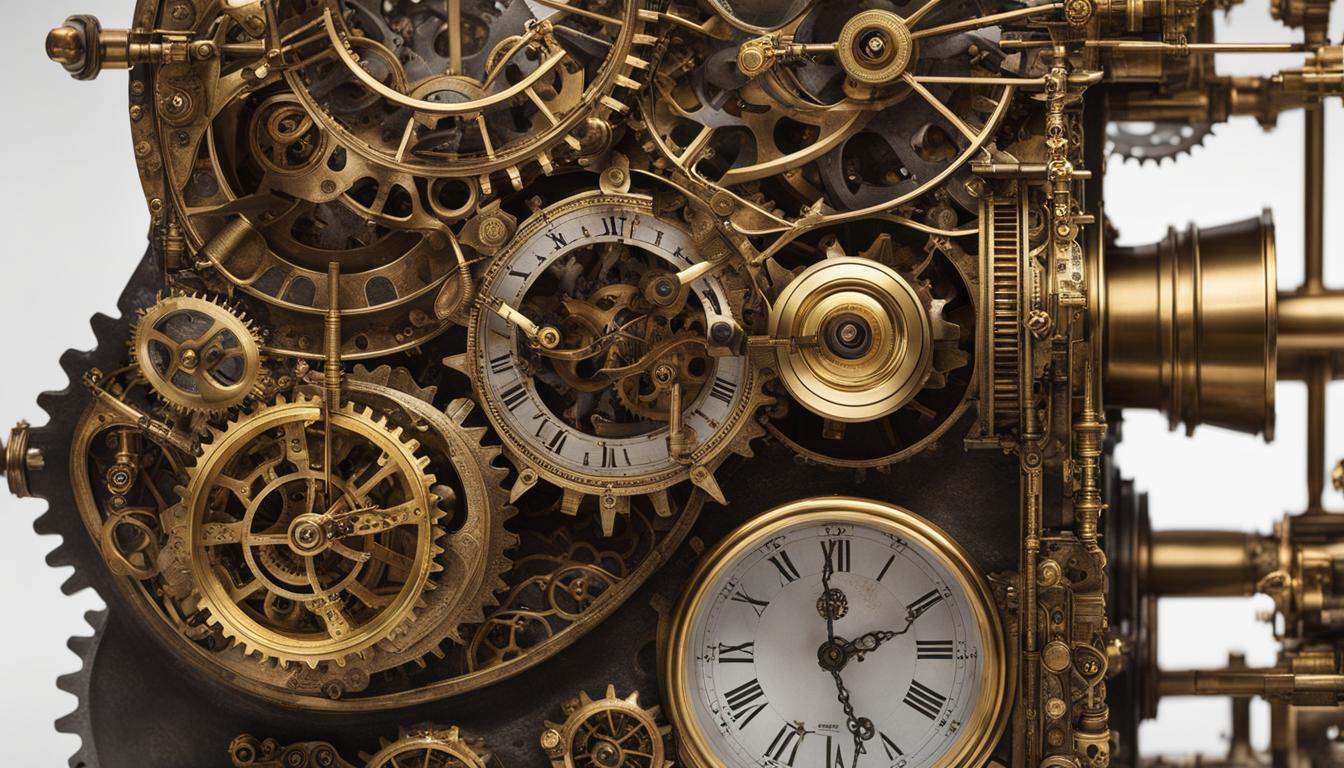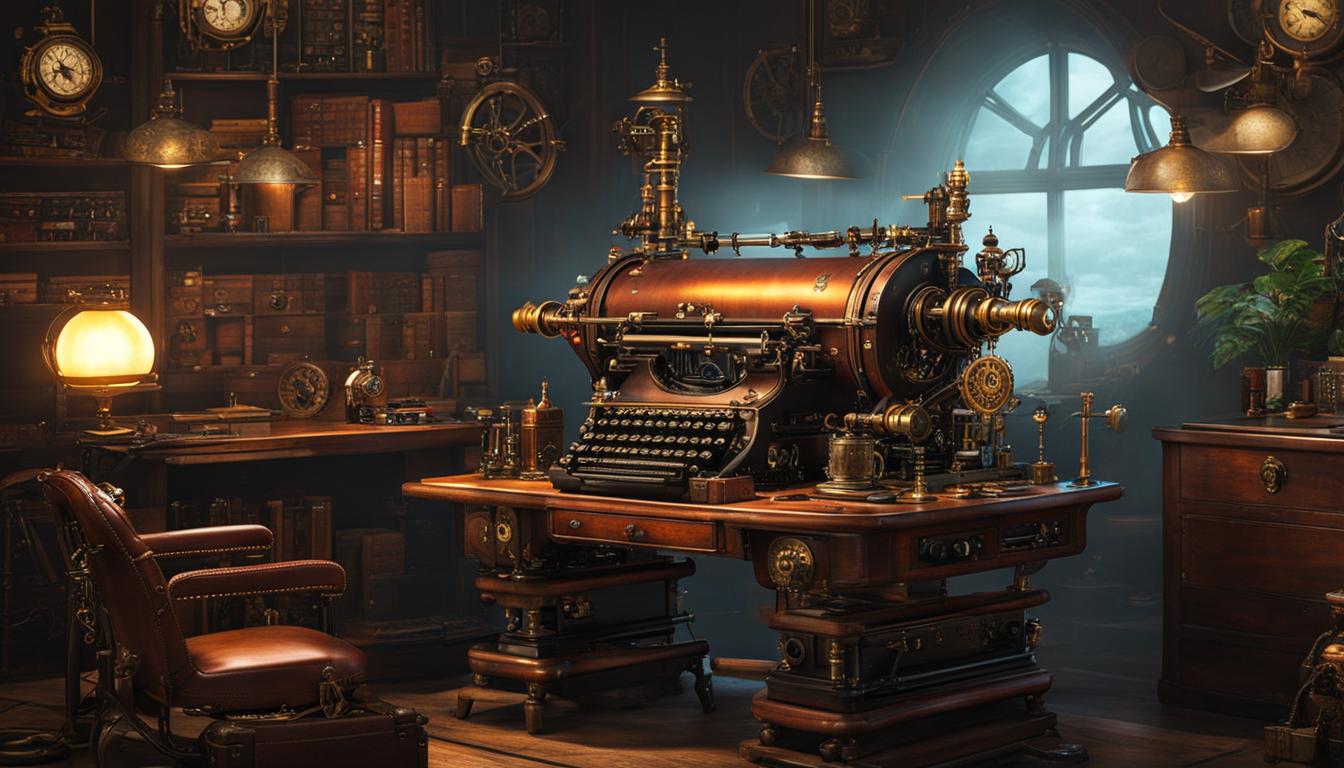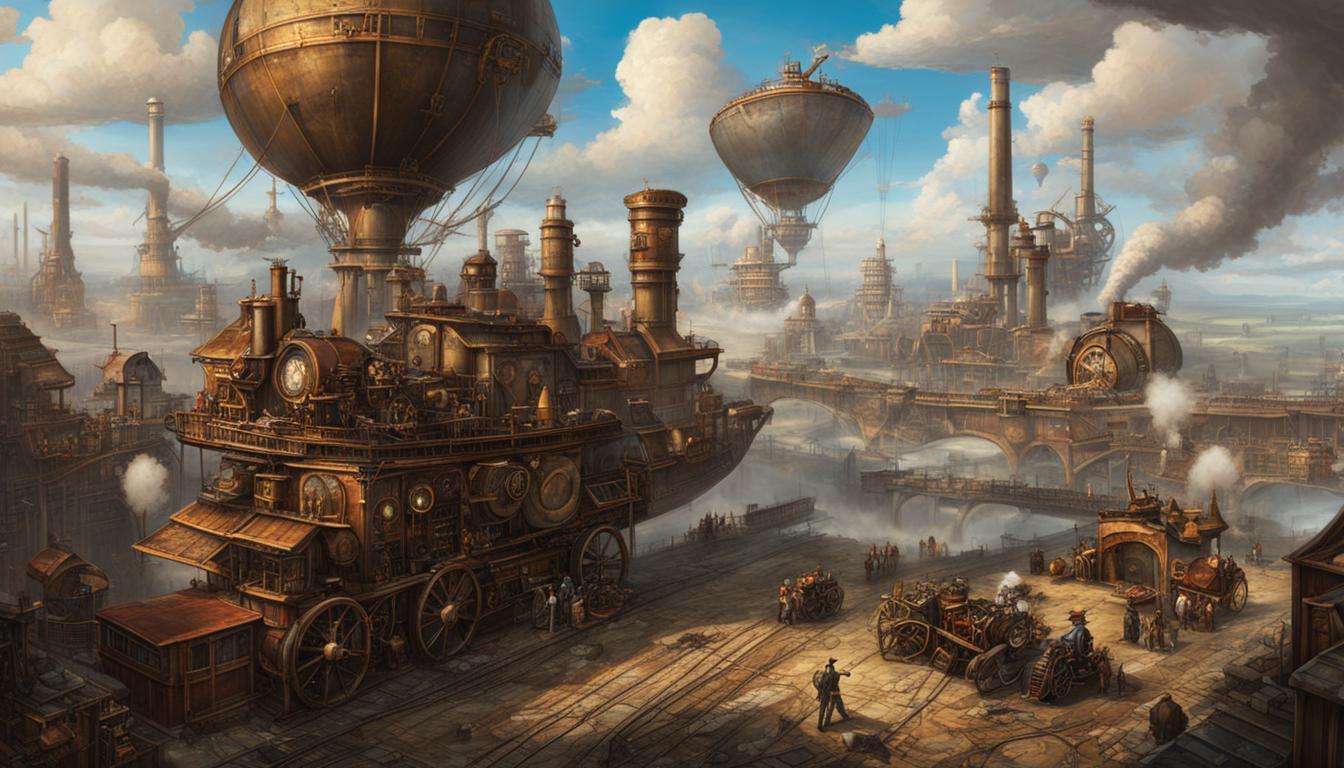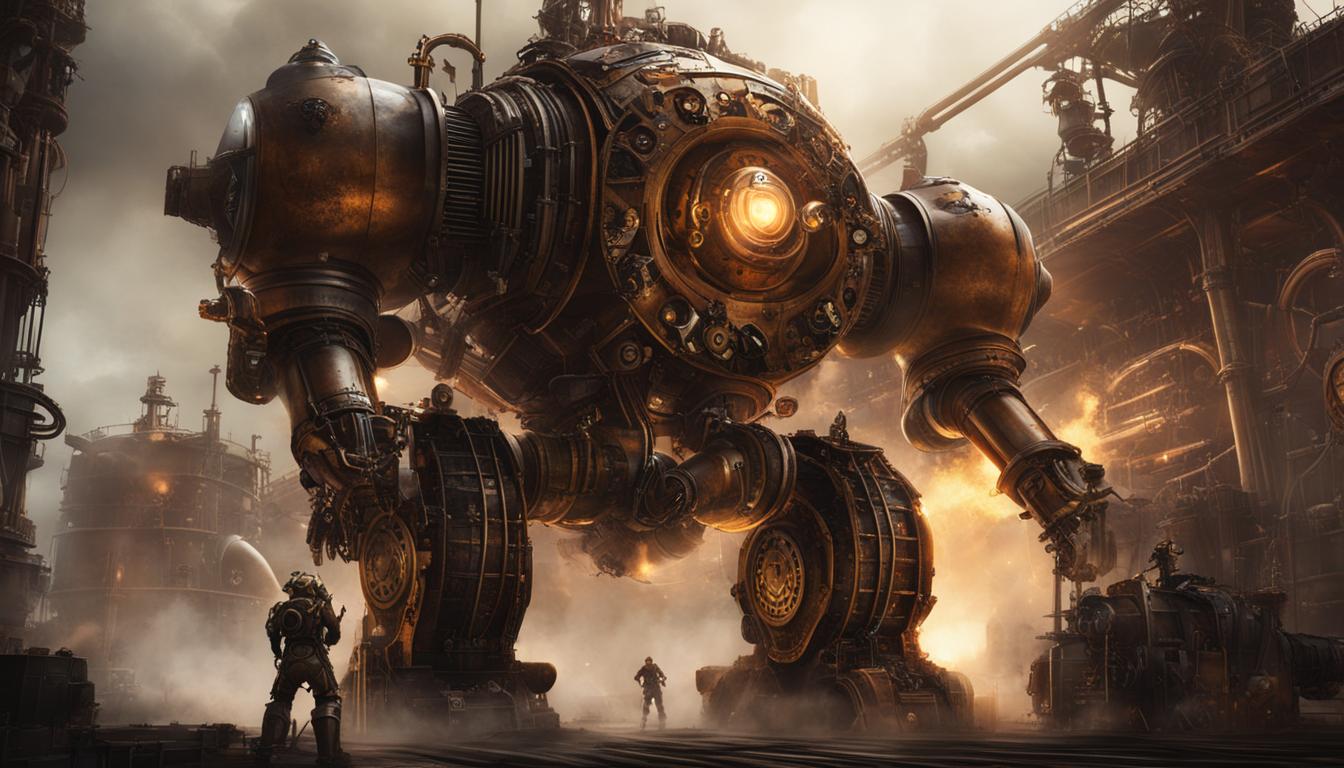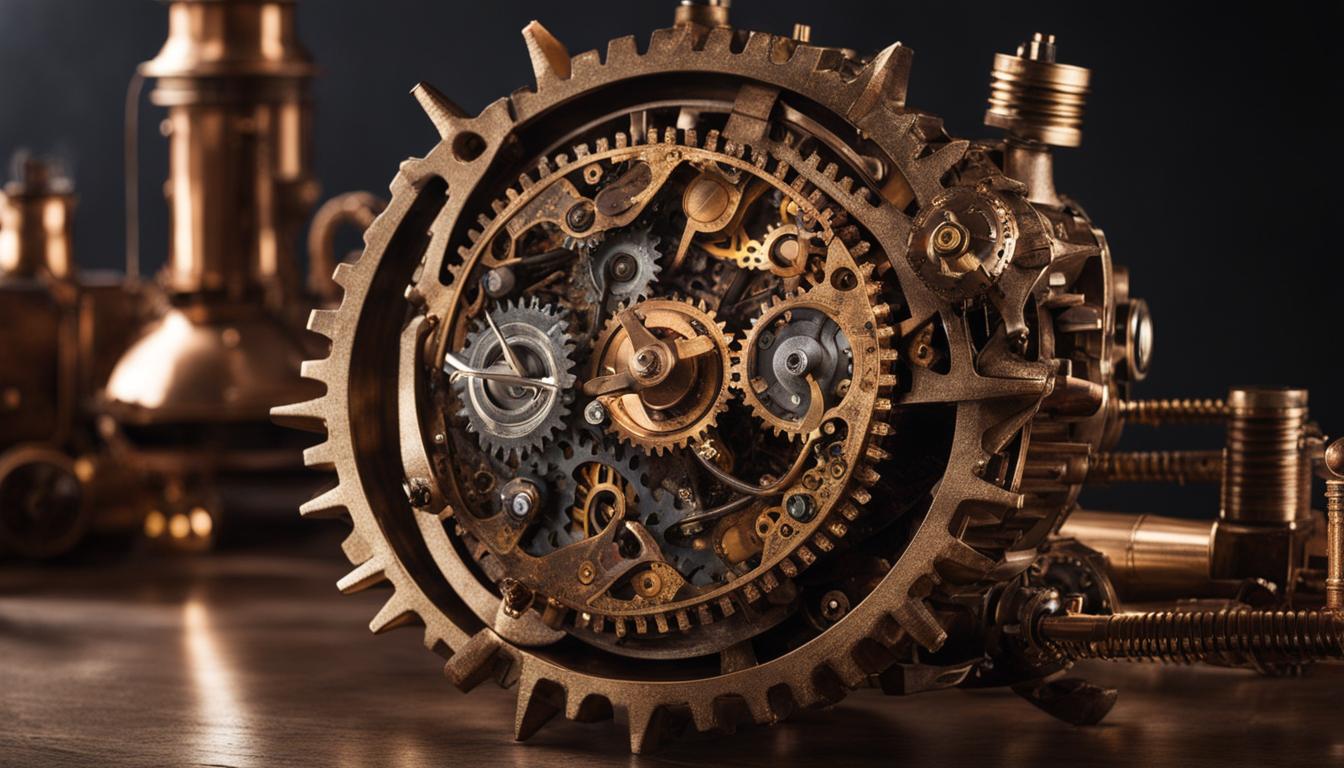Steampunk, the intriguing subgenre of science fiction, is a captivating fusion of history and fantasy. Drawing inspiration from the Victorian era and the Industrial Revolution, it combines retrofuturistic technology and aesthetics with an anachronistic twist. Steampunk transports us to a world where steam power never faded, where 19th-century industrial machinery reigns supreme, and where alternate histories unfold. Let’s delve into the historical influences that shape this captivating genre.
Key Takeaways:
- Steampunk is a subgenre of science fiction that incorporates retrofuturistic technology and aesthetics.
- It draws inspiration from the Victorian era and the Industrial Revolution.
- Steampunk features anachronistic technologies and alternative history scenarios.
- The genre has developed into a vibrant subculture with its own fashion, art, and music.
- Steampunk conventions provide a platform for enthusiasts to celebrate their love for steampunk.
Victorian Era Inspiration
One of the main influences in the steampunk genre is the Victorian era. This period in history, which spanned from 1837 to 1901, serves as a rich source of inspiration for the aesthetics and themes found in steampunk creations.
Steampunk fashion often incorporates elements from Victorian clothing, such as corsets, top hats, and lace-up boots. The Victorian architectural style, with its ornate details and intricate structures, is also reflected in steampunk designs. From towering clockwork buildings to brass and copper accents, the Victorian influence can be seen in every detail.
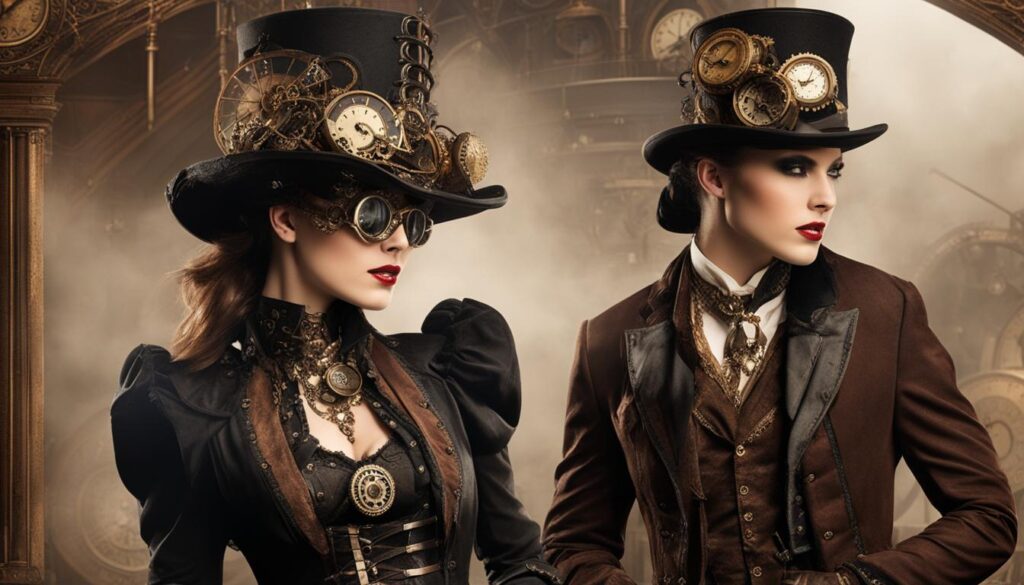
“The Victorian era was a time of incredible innovation and creativity, and that is what we wanted to capture in our steampunk designs.” – Steampunk artist
Victorian art, with its emphasis on romanticism and fantasy, provides another source of inspiration for steampunk. The works of H.G. Wells and Jules Verne, who were active during the Victorian era, also play a significant role in shaping the technology depicted in steampunk. From Wells’ time machines to Verne’s submarines, these iconic inventions are often reimagined as fully functioning steampunk machines.
| Victorian Era Inspiration in Steampunk | Examples |
|---|---|
| Steampunk Fashion | Corsets, top hats, lace-up boots |
| Victorian Architecture | Towering clockwork buildings, brass accents |
| Victorian Art | Romanticism, fantasy |
| Inspiration from H.G. Wells | Time machines |
| Inspiration from Jules Verne | Submarines |
The Victorian era continues to captivate the imagination of steampunk enthusiasts, serving as a foundation for the genre’s unique blend of history and fantasy.
Industrial Revolution Innovations
The Industrial Revolution played a pivotal role in shaping the technology and aesthetics of the steampunk genre. At the heart of steampunk lies the concept of steam-powered machinery, which was a hallmark of the Industrial Revolution. In steampunk, steam power is often used as a source of energy for various machines and inventions.
One of the most iconic representations of steam power in steampunk is the steam-powered train. These majestic locomotives, with their billowing smokestacks and intricate gears, are a common sight in steampunk settings. They evoke a sense of wonder and nostalgia for the bygone era of steam-powered transportation.
But it’s not just trains that are powered by steam in the world of steampunk. Steam-powered cars, with their ornate designs and futuristic yet retro aesthetics, also make appearances. These vehicles capture the spirit of innovation that defined the Industrial Revolution, combining historical inventions and fictional elements to create a unique vision of transportation.
| Industrial Revolution Innovations in Steampunk | Description |
|---|---|
| Steam-powered trains | Iconic representations of steam power in steampunk settings, evoking nostalgia and wonder. |
| Steam-powered cars | Combining historical inventions and fictional elements to create unique vehicles with retro-futuristic aesthetics. |
The Industrial Revolution not only brought about technological advancements but also influenced the visual aesthetics of steampunk. The prominent use of visible gears, valves, and pipes in steampunk design is a direct nod to the machinery of the Industrial Revolution. These elements not only add a sense of authenticity to the genre but also create a visually captivating and intricate world.
While steampunk is a work of fiction, its incorporation of historical inventions and themes allows us to explore the possibilities of what could have been. It’s a tribute to the ingenuity and innovation of the Industrial Revolution, and a reminder of the impact it had on shaping our world.
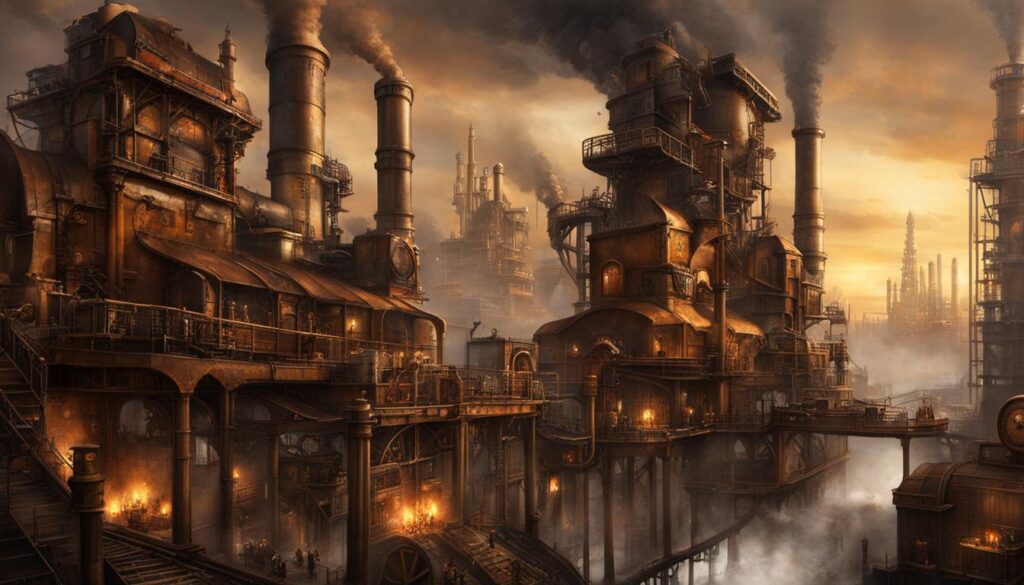
Alternative History Scenarios
Steampunk is known for its imaginative exploration of alternative history scenarios, offering unique narratives set in the Victorian era or the American Wild West. In these fictional worlds, steam power remains the dominant source of energy, leading to the creation of anachronistic technologies and retrofuturistic inventions.
One of the fascinating aspects of steampunk is its ability to transport readers and viewers to a time and place where steam-powered machines rule the day. Whether it’s envisioning a Wild West where steam-driven locomotives dominate the open range or an alternative Victorian era where steam-powered airships fill the skies, steampunk authors and artists delight in crafting these captivating alternate histories.
Steampunk offers a tantalizing glimpse into what could have been, inviting us to ponder the possibilities of a world powered by steam.
But it’s not just the technology that sets steampunk apart. The genre often incorporates elements from other genres, such as fantasy and science fiction, adding an extra layer of intrigue to these alternative history narratives. From fantastical creatures and magic-infused machinery to tales of daring adventures and epic battles, steampunk weaves together a tapestry of imagination and exploration.
Steampunk Incorporating Fantasy
One of the reasons steampunk is so appealing to fans is its ability to seamlessly blend historical elements with fantastical elements. By incorporating elements of fantasy into their creations, steampunk authors and artists can expand the possibilities of their alternative history scenarios. Whether it’s the inclusion of mythical creatures like dragons or the incorporation of magical artifacts and spells, steampunk allows for a broader exploration of the imagination.
| Steampunk Element | Example |
|---|---|
| Fictional Machines | The Difference Engine – a steam-powered computer capable of predicting the future. |
| Magical Artifacts | A steam-powered amulet that grants the wearer the ability to control time. |
| Steampunk Airships | The “Sky Leviathan” – a massive steam-powered airship that doubles as a floating fortress. |
By embracing fantasy in addition to historical accuracy, steampunk opens up a world of possibilities, captivating audiences with its rich tapestry of imagination, adventure, and wonder.
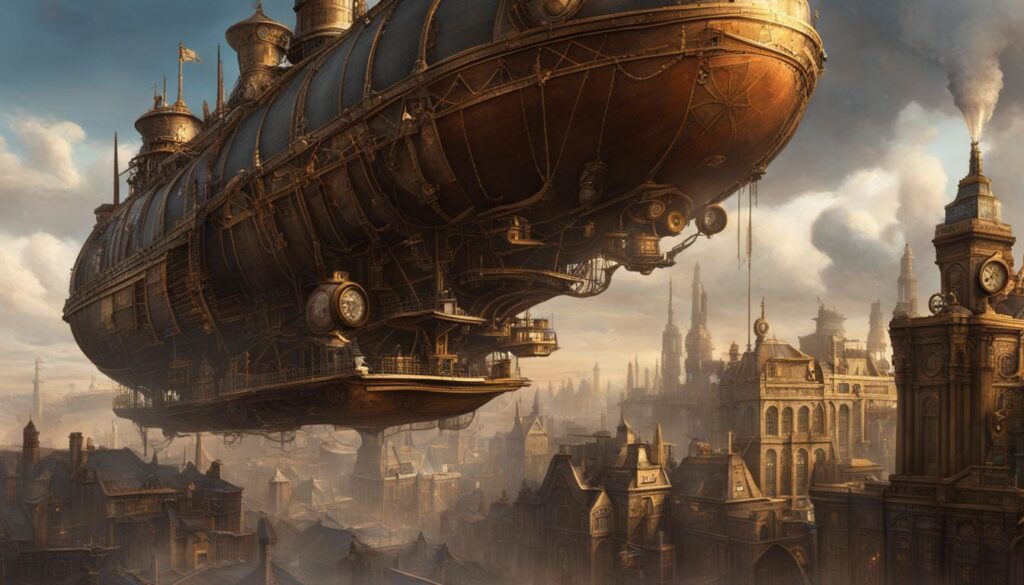
Steampunk Addressing Real-World Issues
While steampunk is primarily a form of speculative fiction, it also has the power to address real-world social issues through its alternative history settings. By reimagining the past and presenting it through the lens of steampunk, creators can explore and comment on contemporary themes in a thought-provoking way. Whether it’s examining issues of class inequality, gender roles, or environmental concerns, steampunk offers a unique platform for social commentary.
Furthermore, steampunk’s ability to blend historical accuracy with fantastical elements provides a captivating way to approach these complex issues. By presenting them in a familiar yet altered context, steampunk challenges readers and viewers to consider alternative perspectives and to reflect on the impact of history on the present.
Steampunk as a Subculture
Steampunk has evolved into more than just a genre of fiction. It has become a thriving subculture that encompasses fashion, art, music, and community. Steampunk fashion draws inspiration from the Victorian era, with its corsets, top hats, and elegant attire. But it also incorporates fantastical elements like goggles, gears, and mechanical accessories, giving it a unique and imaginative twist. The fashion is not just limited to clothing, but also extends to jewelry, footwear, and even costumes for events and conventions.
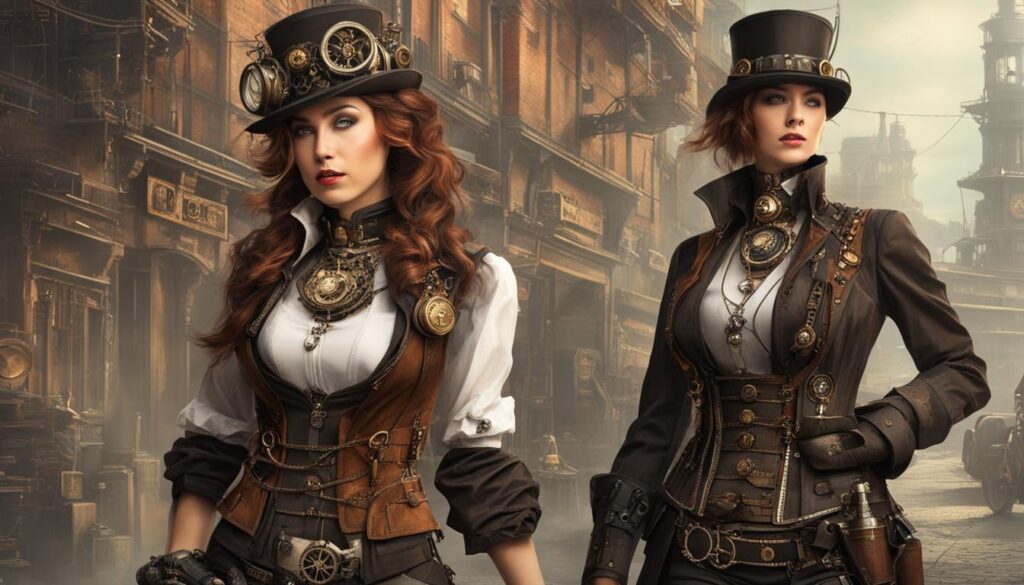
The influence of steampunk can also be seen in the world of art. Steampunk artwork often combines elements of history, technology, and fantasy, creating stunning visuals that transport viewers to a world of retrofuturistic wonders. Artists utilize various mediums, such as painting, illustration, sculpture, and even digital art, to bring their steampunk visions to life. The art often features intricate details, mechanical contraptions, and Victorian aesthetics, captivating the imagination and leaving a lasting impression.
Music plays an important role in the steampunk subculture, providing a soundtrack that complements the retrofuturistic vibe. Steampunk music blends traditional instruments, like violins and accordions, with electronic and synthesized sounds, creating a unique fusion of old and new. Bands and musicians within the steampunk community embrace this musical style, producing music that reflects the themes and atmosphere of the genre. Steampunk music can range from hauntingly beautiful melodies to energetic, foot-stomping tunes.
One of the highlights of the steampunk subculture is the conventions that bring enthusiasts together from around the world. Steampunk conventions offer a space for people to showcase their creativity, connect with like-minded individuals, and immerse themselves in the steampunk world. These events often feature costume contests, panels and workshops, live performances, and a marketplace for artisans to sell their steampunk creations. The international steampunk community is a close-knit and passionate group that continues to grow and thrive.
Table: Steampunk Conventions
| Convention Name | Location | Date |
|---|---|---|
| Steampunk World’s Fair | Piscataway, New Jersey, USA | May |
| Asylum Steampunk Festival | Lincoln, England | August |
| Wild West Steam Fest | San Francisco, California, USA | September |
| Steampunk NZ Festival | Oamaru, New Zealand | June |
| Steampunk World Fair | San Juan, Puerto Rico | October |
Steampunk is more than just a genre; it’s a vibrant subculture that celebrates creativity, imagination, and a love for all things retrofuturistic. From its distinct fashion and awe-inspiring artwork to its unique blend of traditional and electronic music, steampunk offers a captivating and immersive experience. With conventions held worldwide, the international steampunk community continues to grow, forging connections and inspiring new visions within this fantastical realm.
Conclusion
Steampunk is a captivating subgenre that seamlessly blends history and technology, creating a unique and imaginative world. With its historical influences and retrofuturistic aesthetics, steampunk has become a popular form of speculative fiction and a thriving subculture.
Steampunk technology and aesthetics are heavily inspired by the Victorian era and the Industrial Revolution. Anachronistic inventions, steam-powered machinery, and alternative history scenarios are common elements found in steampunk creations, adding to the genre’s allure.
As a subculture, steampunk has fostered its own community of enthusiasts who celebrate the genre through fashion, art, and music. Steampunk conventions around the world provide a platform for like-minded individuals to come together and share their love for all things steampunk.
From the fusion of history and fantasy to the captivating subculture it has become, steampunk continues to captivate audiences with its unique blend of aesthetics and technology. The genre’s ability to transport us to an alternate past filled with imaginative inventions is what keeps us enthralled and eagerly awaiting the next steampunk adventure.
FAQ
What is steampunk?
Steampunk is a subgenre of science fiction that incorporates retrofuturistic technology and aesthetics inspired by 19th-century industrial steam-powered machinery.
What are the historical influences in steampunk technology?
Steampunk draws inspiration from the Victorian era and the Industrial Revolution, incorporating elements of retrofuturistic inventions and alternative history presentations of steam-powered machines.
How does the Victorian era inspire steampunk?
The fashion, culture, architectural style, and art of the Victorian era are often reflected in steampunk creations, with elements such as corsets, top hats, ornate details, and romanticism being commonly seen.
How does the Industrial Revolution influence steampunk?
The advancements in steam-powered machinery during the Industrial Revolution, such as steam engines and the telegraph, are reimagined in steampunk, along with the aesthetic of visible gears, valves, and pipes.
What are the alternative history scenarios in steampunk?
Steampunk often presents fictional scenarios set in the Victorian era or the American Wild West, imagining a world where steam power remains dominant and incorporating anachronistic technologies and retrofuturistic inventions.
What is the steampunk subculture?
Steampunk has developed into a vibrant subculture with its own fashion, art, and music, drawing heavily from the Victorian era and incorporating elements of fantasy and science fiction.

